Analyzing AI's Impact on the Medical Imaging Business Model
VerifiedAdded on 2021/02/20
|9
|2684
|71
Report
AI Summary
This report delves into the transformative impact of artificial intelligence (AI) on the medical imaging industry's business model. It begins with a literature review, examining the healthcare industry, its challenges, and the role of innovation. The report then explores the application of big data and AI within healthcare, highlighting their effects on the healthcare value chain and the emergence of new ecosystems. A significant portion is dedicated to the medical imaging industry, analyzing the integration of AI technologies such as machine learning and deep learning. The report covers the benefits of AI, including improved accuracy and productivity, while also addressing challenges like regulatory processes and vendor integration. The report concludes by emphasizing the crucial role of technology in healthcare and the potential for AI to revolutionize medical imaging, ultimately improving patient care and outcomes.
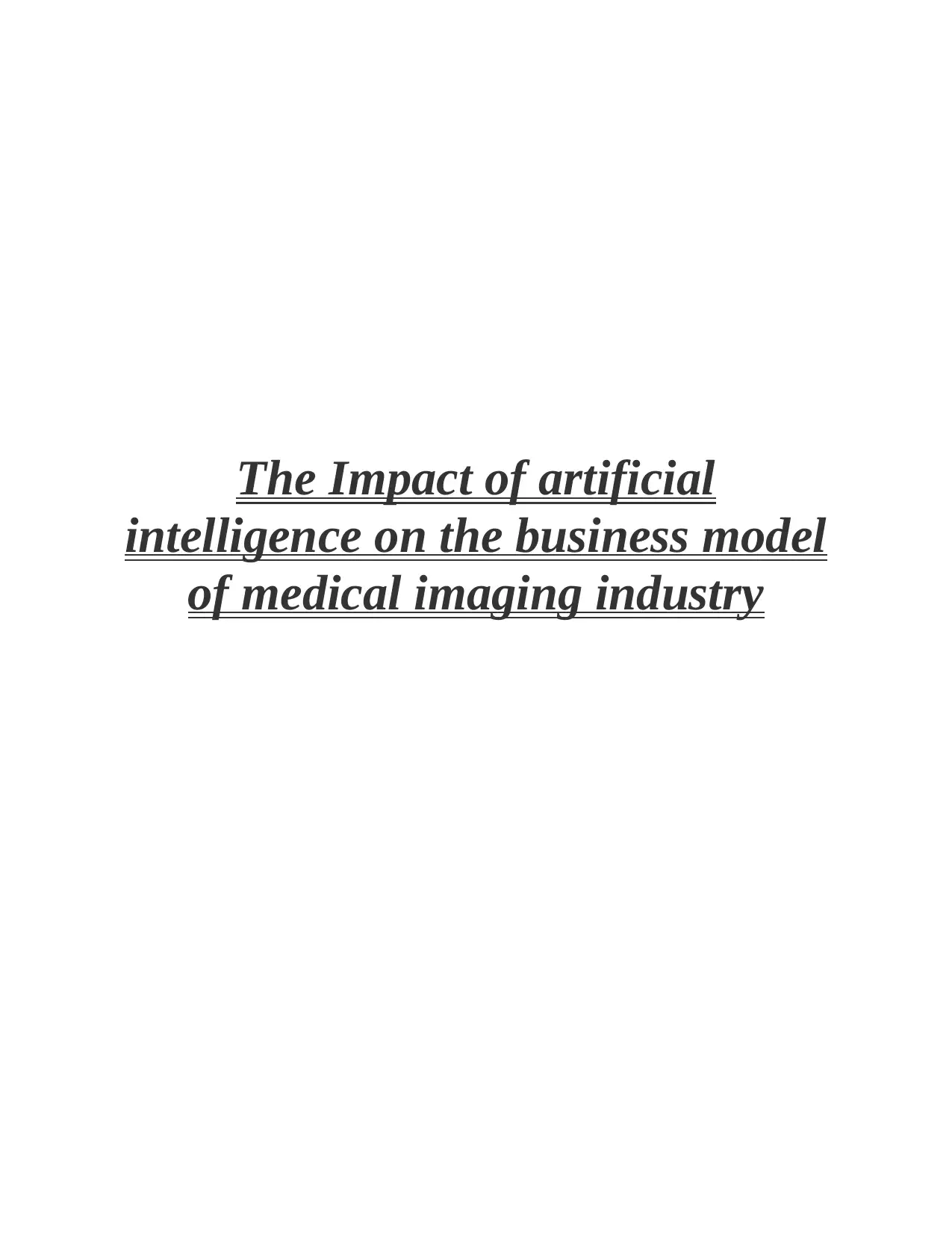
The Impact of artificial
intelligence on the business model
of medical imaging industry
intelligence on the business model
of medical imaging industry
Paraphrase This Document
Need a fresh take? Get an instant paraphrase of this document with our AI Paraphraser
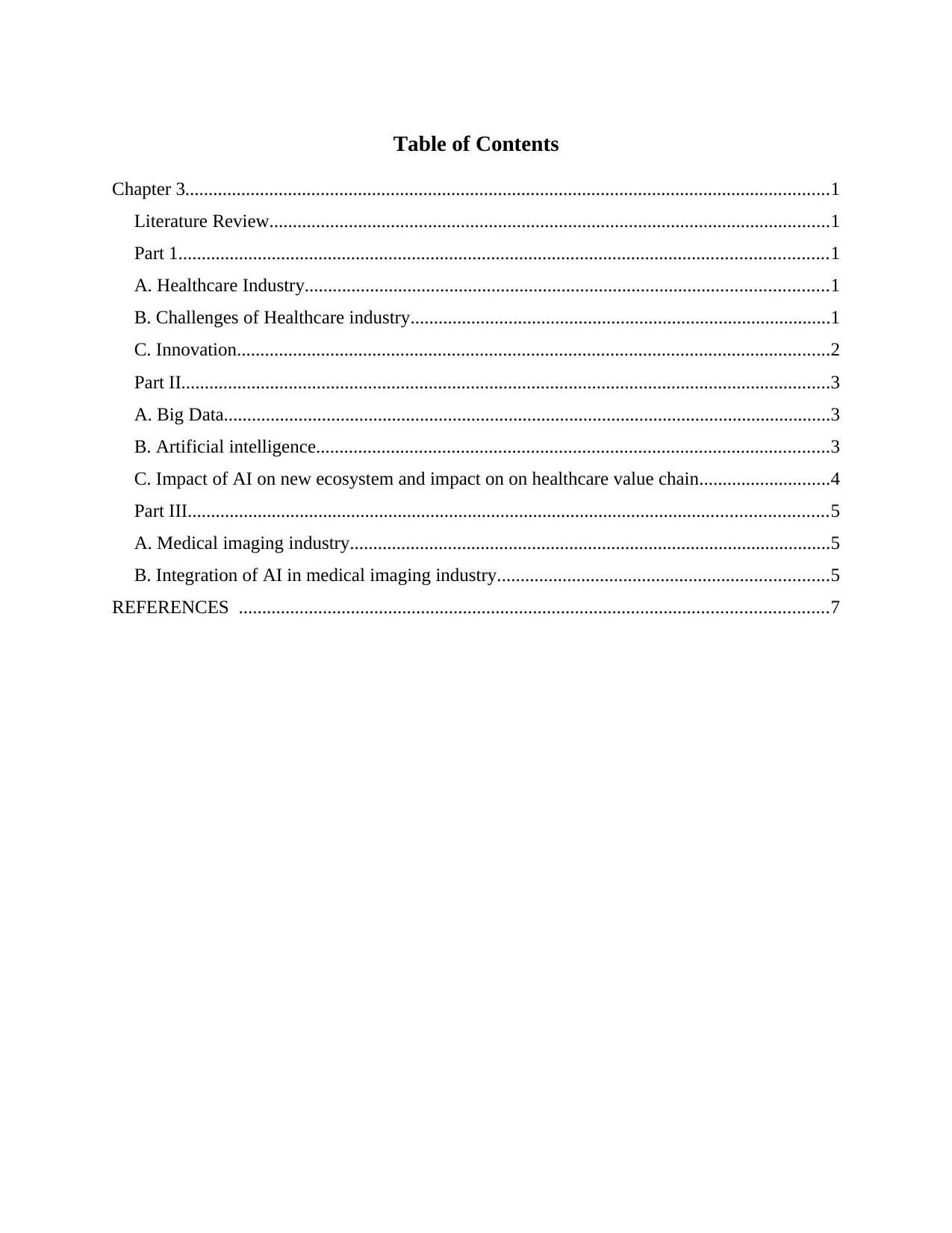
Table of Contents
Chapter 3..........................................................................................................................................1
Literature Review........................................................................................................................1
Part 1...........................................................................................................................................1
A. Healthcare Industry................................................................................................................1
B. Challenges of Healthcare industry..........................................................................................1
C. Innovation...............................................................................................................................2
Part II...........................................................................................................................................3
A. Big Data..................................................................................................................................3
B. Artificial intelligence..............................................................................................................3
C. Impact of AI on new ecosystem and impact on on healthcare value chain............................4
Part III.........................................................................................................................................5
A. Medical imaging industry.......................................................................................................5
B. Integration of AI in medical imaging industry.......................................................................5
REFERENCES ..............................................................................................................................7
Chapter 3..........................................................................................................................................1
Literature Review........................................................................................................................1
Part 1...........................................................................................................................................1
A. Healthcare Industry................................................................................................................1
B. Challenges of Healthcare industry..........................................................................................1
C. Innovation...............................................................................................................................2
Part II...........................................................................................................................................3
A. Big Data..................................................................................................................................3
B. Artificial intelligence..............................................................................................................3
C. Impact of AI on new ecosystem and impact on on healthcare value chain............................4
Part III.........................................................................................................................................5
A. Medical imaging industry.......................................................................................................5
B. Integration of AI in medical imaging industry.......................................................................5
REFERENCES ..............................................................................................................................7
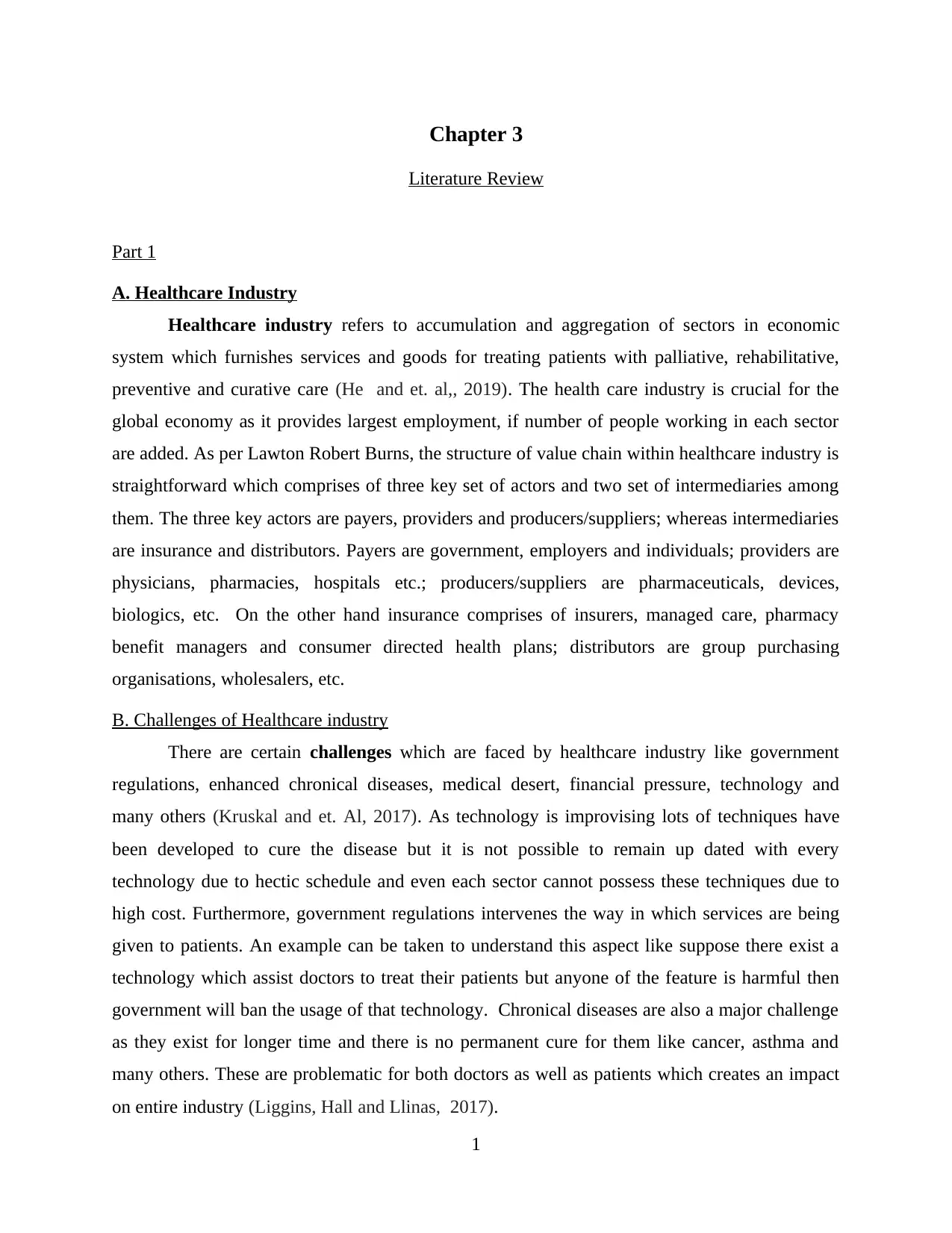
Chapter 3
Literature Review
Part 1
A. Healthcare Industry
Healthcare industry refers to accumulation and aggregation of sectors in economic
system which furnishes services and goods for treating patients with palliative, rehabilitative,
preventive and curative care (He and et. al,, 2019). The health care industry is crucial for the
global economy as it provides largest employment, if number of people working in each sector
are added. As per Lawton Robert Burns, the structure of value chain within healthcare industry is
straightforward which comprises of three key set of actors and two set of intermediaries among
them. The three key actors are payers, providers and producers/suppliers; whereas intermediaries
are insurance and distributors. Payers are government, employers and individuals; providers are
physicians, pharmacies, hospitals etc.; producers/suppliers are pharmaceuticals, devices,
biologics, etc. On the other hand insurance comprises of insurers, managed care, pharmacy
benefit managers and consumer directed health plans; distributors are group purchasing
organisations, wholesalers, etc.
B. Challenges of Healthcare industry
There are certain challenges which are faced by healthcare industry like government
regulations, enhanced chronical diseases, medical desert, financial pressure, technology and
many others (Kruskal and et. Al, 2017). As technology is improvising lots of techniques have
been developed to cure the disease but it is not possible to remain up dated with every
technology due to hectic schedule and even each sector cannot possess these techniques due to
high cost. Furthermore, government regulations intervenes the way in which services are being
given to patients. An example can be taken to understand this aspect like suppose there exist a
technology which assist doctors to treat their patients but anyone of the feature is harmful then
government will ban the usage of that technology. Chronical diseases are also a major challenge
as they exist for longer time and there is no permanent cure for them like cancer, asthma and
many others. These are problematic for both doctors as well as patients which creates an impact
on entire industry (Liggins, Hall and Llinas, 2017).
1
Literature Review
Part 1
A. Healthcare Industry
Healthcare industry refers to accumulation and aggregation of sectors in economic
system which furnishes services and goods for treating patients with palliative, rehabilitative,
preventive and curative care (He and et. al,, 2019). The health care industry is crucial for the
global economy as it provides largest employment, if number of people working in each sector
are added. As per Lawton Robert Burns, the structure of value chain within healthcare industry is
straightforward which comprises of three key set of actors and two set of intermediaries among
them. The three key actors are payers, providers and producers/suppliers; whereas intermediaries
are insurance and distributors. Payers are government, employers and individuals; providers are
physicians, pharmacies, hospitals etc.; producers/suppliers are pharmaceuticals, devices,
biologics, etc. On the other hand insurance comprises of insurers, managed care, pharmacy
benefit managers and consumer directed health plans; distributors are group purchasing
organisations, wholesalers, etc.
B. Challenges of Healthcare industry
There are certain challenges which are faced by healthcare industry like government
regulations, enhanced chronical diseases, medical desert, financial pressure, technology and
many others (Kruskal and et. Al, 2017). As technology is improvising lots of techniques have
been developed to cure the disease but it is not possible to remain up dated with every
technology due to hectic schedule and even each sector cannot possess these techniques due to
high cost. Furthermore, government regulations intervenes the way in which services are being
given to patients. An example can be taken to understand this aspect like suppose there exist a
technology which assist doctors to treat their patients but anyone of the feature is harmful then
government will ban the usage of that technology. Chronical diseases are also a major challenge
as they exist for longer time and there is no permanent cure for them like cancer, asthma and
many others. These are problematic for both doctors as well as patients which creates an impact
on entire industry (Liggins, Hall and Llinas, 2017).
1
⊘ This is a preview!⊘
Do you want full access?
Subscribe today to unlock all pages.

Trusted by 1+ million students worldwide
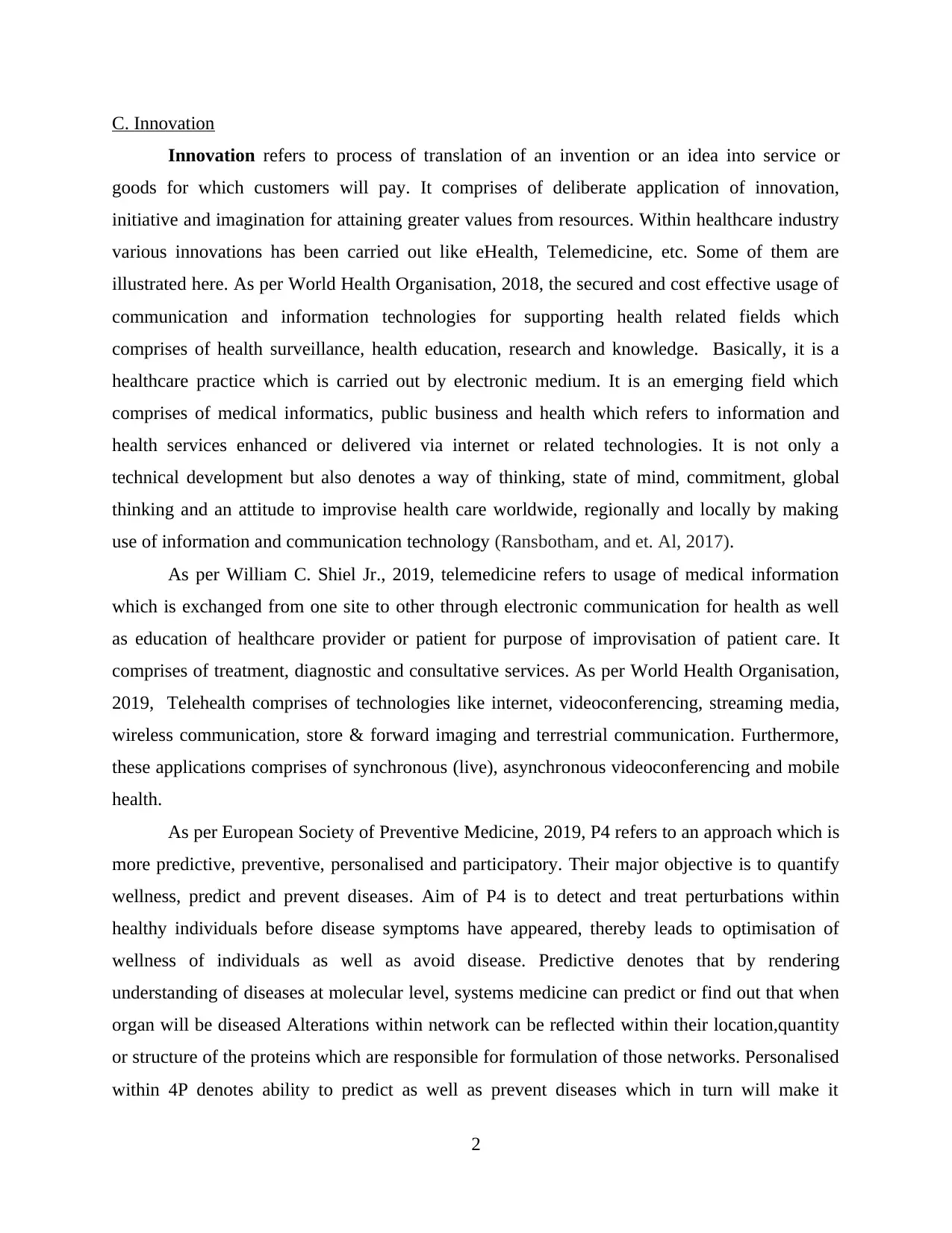
C. Innovation
Innovation refers to process of translation of an invention or an idea into service or
goods for which customers will pay. It comprises of deliberate application of innovation,
initiative and imagination for attaining greater values from resources. Within healthcare industry
various innovations has been carried out like eHealth, Telemedicine, etc. Some of them are
illustrated here. As per World Health Organisation, 2018, the secured and cost effective usage of
communication and information technologies for supporting health related fields which
comprises of health surveillance, health education, research and knowledge. Basically, it is a
healthcare practice which is carried out by electronic medium. It is an emerging field which
comprises of medical informatics, public business and health which refers to information and
health services enhanced or delivered via internet or related technologies. It is not only a
technical development but also denotes a way of thinking, state of mind, commitment, global
thinking and an attitude to improvise health care worldwide, regionally and locally by making
use of information and communication technology (Ransbotham, and et. Al, 2017).
As per William C. Shiel Jr., 2019, telemedicine refers to usage of medical information
which is exchanged from one site to other through electronic communication for health as well
as education of healthcare provider or patient for purpose of improvisation of patient care. It
comprises of treatment, diagnostic and consultative services. As per World Health Organisation,
2019, Telehealth comprises of technologies like internet, videoconferencing, streaming media,
wireless communication, store & forward imaging and terrestrial communication. Furthermore,
these applications comprises of synchronous (live), asynchronous videoconferencing and mobile
health.
As per European Society of Preventive Medicine, 2019, P4 refers to an approach which is
more predictive, preventive, personalised and participatory. Their major objective is to quantify
wellness, predict and prevent diseases. Aim of P4 is to detect and treat perturbations within
healthy individuals before disease symptoms have appeared, thereby leads to optimisation of
wellness of individuals as well as avoid disease. Predictive denotes that by rendering
understanding of diseases at molecular level, systems medicine can predict or find out that when
organ will be diseased Alterations within network can be reflected within their location,quantity
or structure of the proteins which are responsible for formulation of those networks. Personalised
within 4P denotes ability to predict as well as prevent diseases which in turn will make it
2
Innovation refers to process of translation of an invention or an idea into service or
goods for which customers will pay. It comprises of deliberate application of innovation,
initiative and imagination for attaining greater values from resources. Within healthcare industry
various innovations has been carried out like eHealth, Telemedicine, etc. Some of them are
illustrated here. As per World Health Organisation, 2018, the secured and cost effective usage of
communication and information technologies for supporting health related fields which
comprises of health surveillance, health education, research and knowledge. Basically, it is a
healthcare practice which is carried out by electronic medium. It is an emerging field which
comprises of medical informatics, public business and health which refers to information and
health services enhanced or delivered via internet or related technologies. It is not only a
technical development but also denotes a way of thinking, state of mind, commitment, global
thinking and an attitude to improvise health care worldwide, regionally and locally by making
use of information and communication technology (Ransbotham, and et. Al, 2017).
As per William C. Shiel Jr., 2019, telemedicine refers to usage of medical information
which is exchanged from one site to other through electronic communication for health as well
as education of healthcare provider or patient for purpose of improvisation of patient care. It
comprises of treatment, diagnostic and consultative services. As per World Health Organisation,
2019, Telehealth comprises of technologies like internet, videoconferencing, streaming media,
wireless communication, store & forward imaging and terrestrial communication. Furthermore,
these applications comprises of synchronous (live), asynchronous videoconferencing and mobile
health.
As per European Society of Preventive Medicine, 2019, P4 refers to an approach which is
more predictive, preventive, personalised and participatory. Their major objective is to quantify
wellness, predict and prevent diseases. Aim of P4 is to detect and treat perturbations within
healthy individuals before disease symptoms have appeared, thereby leads to optimisation of
wellness of individuals as well as avoid disease. Predictive denotes that by rendering
understanding of diseases at molecular level, systems medicine can predict or find out that when
organ will be diseased Alterations within network can be reflected within their location,quantity
or structure of the proteins which are responsible for formulation of those networks. Personalised
within 4P denotes ability to predict as well as prevent diseases which in turn will make it
2
Paraphrase This Document
Need a fresh take? Get an instant paraphrase of this document with our AI Paraphraser
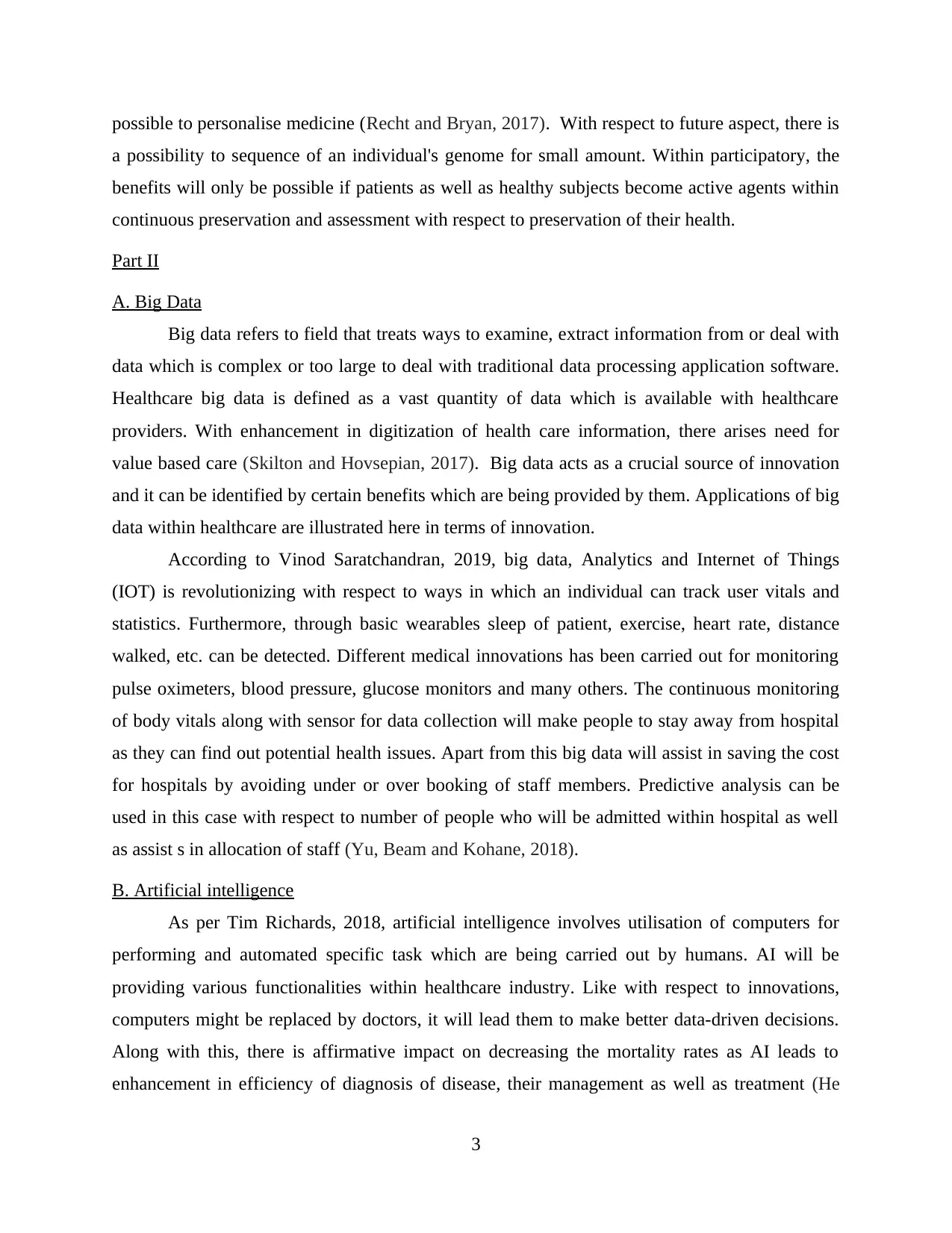
possible to personalise medicine (Recht and Bryan, 2017). With respect to future aspect, there is
a possibility to sequence of an individual's genome for small amount. Within participatory, the
benefits will only be possible if patients as well as healthy subjects become active agents within
continuous preservation and assessment with respect to preservation of their health.
Part II
A. Big Data
Big data refers to field that treats ways to examine, extract information from or deal with
data which is complex or too large to deal with traditional data processing application software.
Healthcare big data is defined as a vast quantity of data which is available with healthcare
providers. With enhancement in digitization of health care information, there arises need for
value based care (Skilton and Hovsepian, 2017). Big data acts as a crucial source of innovation
and it can be identified by certain benefits which are being provided by them. Applications of big
data within healthcare are illustrated here in terms of innovation.
According to Vinod Saratchandran, 2019, big data, Analytics and Internet of Things
(IOT) is revolutionizing with respect to ways in which an individual can track user vitals and
statistics. Furthermore, through basic wearables sleep of patient, exercise, heart rate, distance
walked, etc. can be detected. Different medical innovations has been carried out for monitoring
pulse oximeters, blood pressure, glucose monitors and many others. The continuous monitoring
of body vitals along with sensor for data collection will make people to stay away from hospital
as they can find out potential health issues. Apart from this big data will assist in saving the cost
for hospitals by avoiding under or over booking of staff members. Predictive analysis can be
used in this case with respect to number of people who will be admitted within hospital as well
as assist s in allocation of staff (Yu, Beam and Kohane, 2018).
B. Artificial intelligence
As per Tim Richards, 2018, artificial intelligence involves utilisation of computers for
performing and automated specific task which are being carried out by humans. AI will be
providing various functionalities within healthcare industry. Like with respect to innovations,
computers might be replaced by doctors, it will lead them to make better data-driven decisions.
Along with this, there is affirmative impact on decreasing the mortality rates as AI leads to
enhancement in efficiency of diagnosis of disease, their management as well as treatment (He
3
a possibility to sequence of an individual's genome for small amount. Within participatory, the
benefits will only be possible if patients as well as healthy subjects become active agents within
continuous preservation and assessment with respect to preservation of their health.
Part II
A. Big Data
Big data refers to field that treats ways to examine, extract information from or deal with
data which is complex or too large to deal with traditional data processing application software.
Healthcare big data is defined as a vast quantity of data which is available with healthcare
providers. With enhancement in digitization of health care information, there arises need for
value based care (Skilton and Hovsepian, 2017). Big data acts as a crucial source of innovation
and it can be identified by certain benefits which are being provided by them. Applications of big
data within healthcare are illustrated here in terms of innovation.
According to Vinod Saratchandran, 2019, big data, Analytics and Internet of Things
(IOT) is revolutionizing with respect to ways in which an individual can track user vitals and
statistics. Furthermore, through basic wearables sleep of patient, exercise, heart rate, distance
walked, etc. can be detected. Different medical innovations has been carried out for monitoring
pulse oximeters, blood pressure, glucose monitors and many others. The continuous monitoring
of body vitals along with sensor for data collection will make people to stay away from hospital
as they can find out potential health issues. Apart from this big data will assist in saving the cost
for hospitals by avoiding under or over booking of staff members. Predictive analysis can be
used in this case with respect to number of people who will be admitted within hospital as well
as assist s in allocation of staff (Yu, Beam and Kohane, 2018).
B. Artificial intelligence
As per Tim Richards, 2018, artificial intelligence involves utilisation of computers for
performing and automated specific task which are being carried out by humans. AI will be
providing various functionalities within healthcare industry. Like with respect to innovations,
computers might be replaced by doctors, it will lead them to make better data-driven decisions.
Along with this, there is affirmative impact on decreasing the mortality rates as AI leads to
enhancement in efficiency of diagnosis of disease, their management as well as treatment (He
3
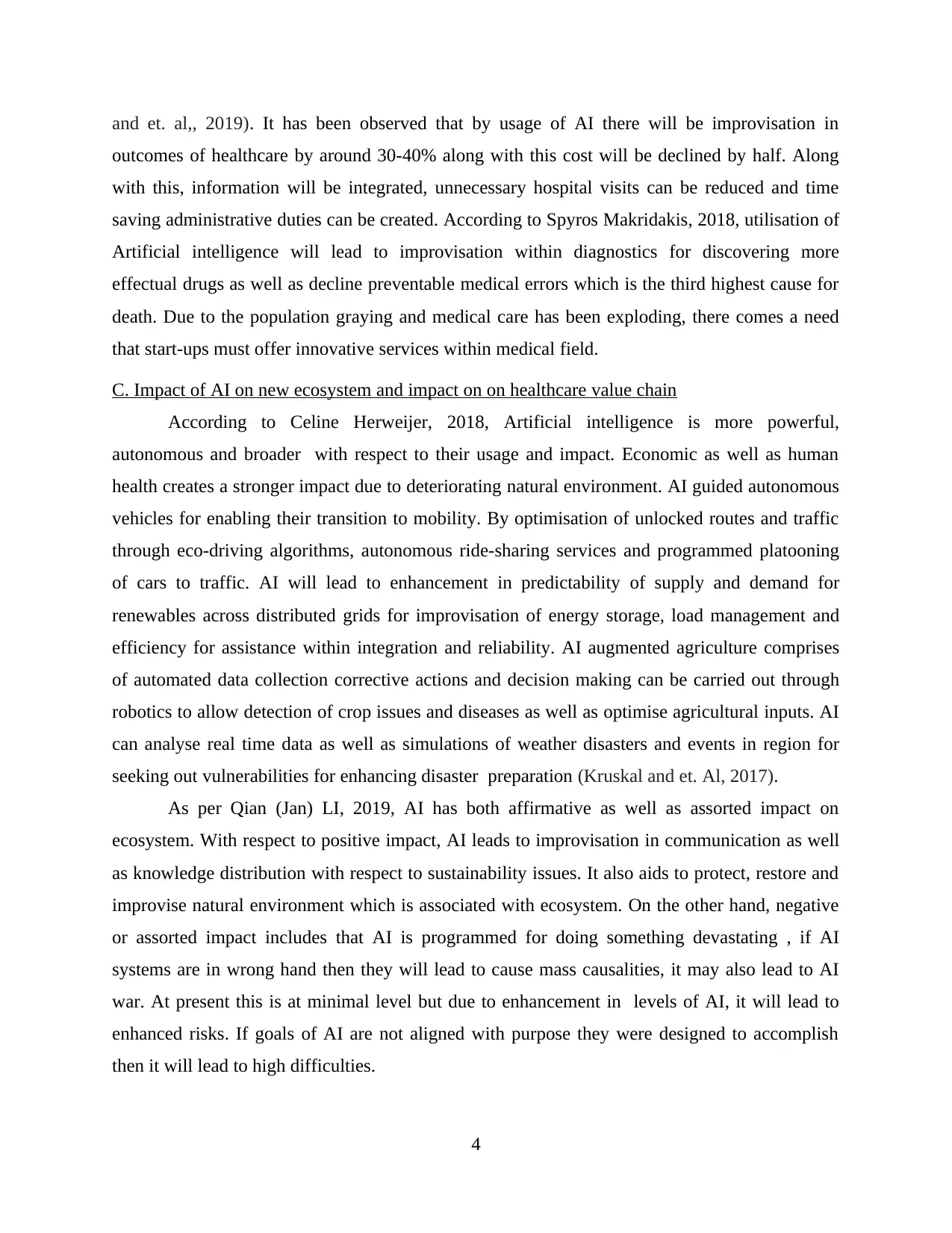
and et. al,, 2019). It has been observed that by usage of AI there will be improvisation in
outcomes of healthcare by around 30-40% along with this cost will be declined by half. Along
with this, information will be integrated, unnecessary hospital visits can be reduced and time
saving administrative duties can be created. According to Spyros Makridakis, 2018, utilisation of
Artificial intelligence will lead to improvisation within diagnostics for discovering more
effectual drugs as well as decline preventable medical errors which is the third highest cause for
death. Due to the population graying and medical care has been exploding, there comes a need
that start-ups must offer innovative services within medical field.
C. Impact of AI on new ecosystem and impact on on healthcare value chain
According to Celine Herweijer, 2018, Artificial intelligence is more powerful,
autonomous and broader with respect to their usage and impact. Economic as well as human
health creates a stronger impact due to deteriorating natural environment. AI guided autonomous
vehicles for enabling their transition to mobility. By optimisation of unlocked routes and traffic
through eco-driving algorithms, autonomous ride-sharing services and programmed platooning
of cars to traffic. AI will lead to enhancement in predictability of supply and demand for
renewables across distributed grids for improvisation of energy storage, load management and
efficiency for assistance within integration and reliability. AI augmented agriculture comprises
of automated data collection corrective actions and decision making can be carried out through
robotics to allow detection of crop issues and diseases as well as optimise agricultural inputs. AI
can analyse real time data as well as simulations of weather disasters and events in region for
seeking out vulnerabilities for enhancing disaster preparation (Kruskal and et. Al, 2017).
As per Qian (Jan) LI, 2019, AI has both affirmative as well as assorted impact on
ecosystem. With respect to positive impact, AI leads to improvisation in communication as well
as knowledge distribution with respect to sustainability issues. It also aids to protect, restore and
improvise natural environment which is associated with ecosystem. On the other hand, negative
or assorted impact includes that AI is programmed for doing something devastating , if AI
systems are in wrong hand then they will lead to cause mass causalities, it may also lead to AI
war. At present this is at minimal level but due to enhancement in levels of AI, it will lead to
enhanced risks. If goals of AI are not aligned with purpose they were designed to accomplish
then it will lead to high difficulties.
4
outcomes of healthcare by around 30-40% along with this cost will be declined by half. Along
with this, information will be integrated, unnecessary hospital visits can be reduced and time
saving administrative duties can be created. According to Spyros Makridakis, 2018, utilisation of
Artificial intelligence will lead to improvisation within diagnostics for discovering more
effectual drugs as well as decline preventable medical errors which is the third highest cause for
death. Due to the population graying and medical care has been exploding, there comes a need
that start-ups must offer innovative services within medical field.
C. Impact of AI on new ecosystem and impact on on healthcare value chain
According to Celine Herweijer, 2018, Artificial intelligence is more powerful,
autonomous and broader with respect to their usage and impact. Economic as well as human
health creates a stronger impact due to deteriorating natural environment. AI guided autonomous
vehicles for enabling their transition to mobility. By optimisation of unlocked routes and traffic
through eco-driving algorithms, autonomous ride-sharing services and programmed platooning
of cars to traffic. AI will lead to enhancement in predictability of supply and demand for
renewables across distributed grids for improvisation of energy storage, load management and
efficiency for assistance within integration and reliability. AI augmented agriculture comprises
of automated data collection corrective actions and decision making can be carried out through
robotics to allow detection of crop issues and diseases as well as optimise agricultural inputs. AI
can analyse real time data as well as simulations of weather disasters and events in region for
seeking out vulnerabilities for enhancing disaster preparation (Kruskal and et. Al, 2017).
As per Qian (Jan) LI, 2019, AI has both affirmative as well as assorted impact on
ecosystem. With respect to positive impact, AI leads to improvisation in communication as well
as knowledge distribution with respect to sustainability issues. It also aids to protect, restore and
improvise natural environment which is associated with ecosystem. On the other hand, negative
or assorted impact includes that AI is programmed for doing something devastating , if AI
systems are in wrong hand then they will lead to cause mass causalities, it may also lead to AI
war. At present this is at minimal level but due to enhancement in levels of AI, it will lead to
enhanced risks. If goals of AI are not aligned with purpose they were designed to accomplish
then it will lead to high difficulties.
4
⊘ This is a preview!⊘
Do you want full access?
Subscribe today to unlock all pages.

Trusted by 1+ million students worldwide
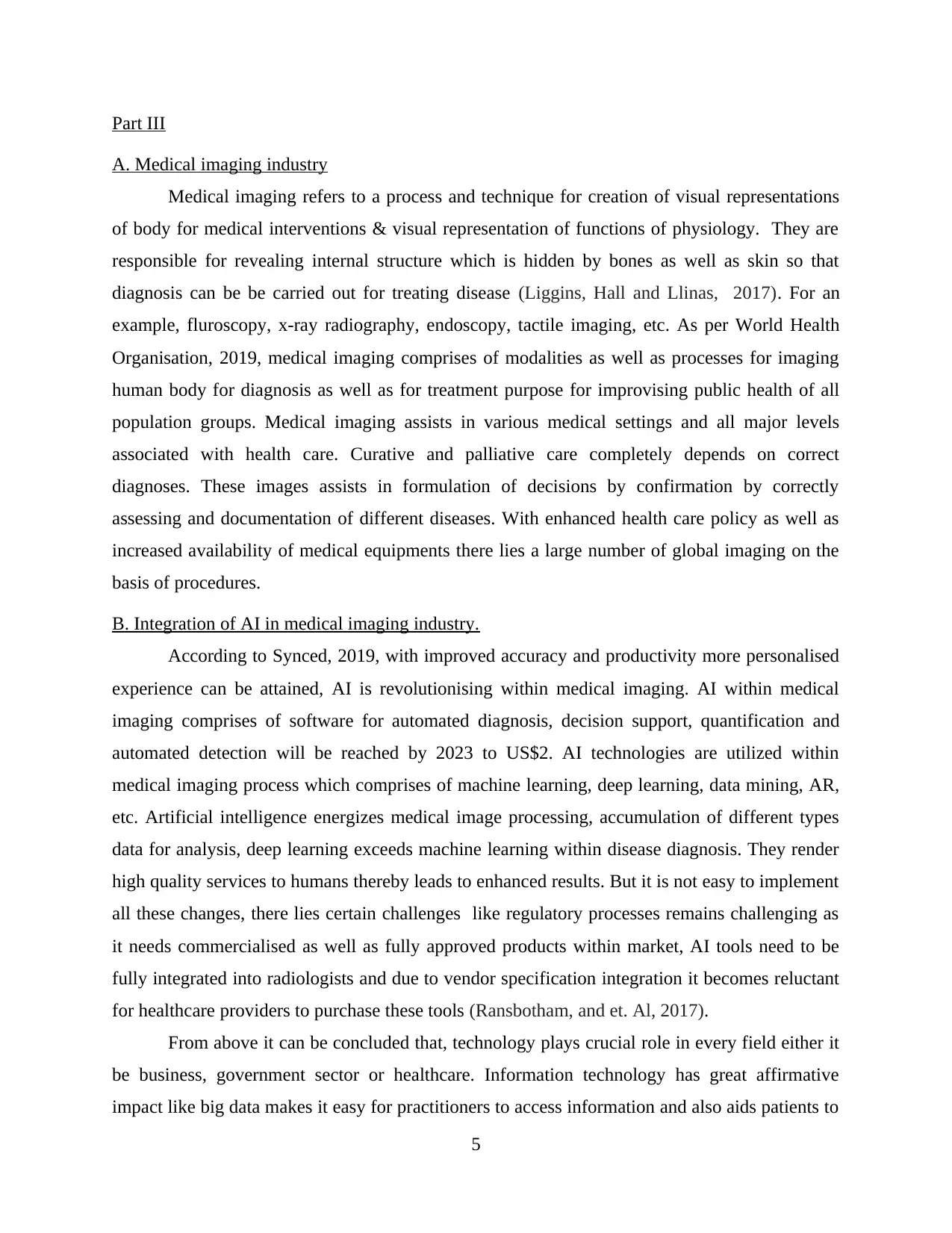
Part III
A. Medical imaging industry
Medical imaging refers to a process and technique for creation of visual representations
of body for medical interventions & visual representation of functions of physiology. They are
responsible for revealing internal structure which is hidden by bones as well as skin so that
diagnosis can be be carried out for treating disease (Liggins, Hall and Llinas, 2017). For an
example, fluroscopy, x-ray radiography, endoscopy, tactile imaging, etc. As per World Health
Organisation, 2019, medical imaging comprises of modalities as well as processes for imaging
human body for diagnosis as well as for treatment purpose for improvising public health of all
population groups. Medical imaging assists in various medical settings and all major levels
associated with health care. Curative and palliative care completely depends on correct
diagnoses. These images assists in formulation of decisions by confirmation by correctly
assessing and documentation of different diseases. With enhanced health care policy as well as
increased availability of medical equipments there lies a large number of global imaging on the
basis of procedures.
B. Integration of AI in medical imaging industry.
According to Synced, 2019, with improved accuracy and productivity more personalised
experience can be attained, AI is revolutionising within medical imaging. AI within medical
imaging comprises of software for automated diagnosis, decision support, quantification and
automated detection will be reached by 2023 to US$2. AI technologies are utilized within
medical imaging process which comprises of machine learning, deep learning, data mining, AR,
etc. Artificial intelligence energizes medical image processing, accumulation of different types
data for analysis, deep learning exceeds machine learning within disease diagnosis. They render
high quality services to humans thereby leads to enhanced results. But it is not easy to implement
all these changes, there lies certain challenges like regulatory processes remains challenging as
it needs commercialised as well as fully approved products within market, AI tools need to be
fully integrated into radiologists and due to vendor specification integration it becomes reluctant
for healthcare providers to purchase these tools (Ransbotham, and et. Al, 2017).
From above it can be concluded that, technology plays crucial role in every field either it
be business, government sector or healthcare. Information technology has great affirmative
impact like big data makes it easy for practitioners to access information and also aids patients to
5
A. Medical imaging industry
Medical imaging refers to a process and technique for creation of visual representations
of body for medical interventions & visual representation of functions of physiology. They are
responsible for revealing internal structure which is hidden by bones as well as skin so that
diagnosis can be be carried out for treating disease (Liggins, Hall and Llinas, 2017). For an
example, fluroscopy, x-ray radiography, endoscopy, tactile imaging, etc. As per World Health
Organisation, 2019, medical imaging comprises of modalities as well as processes for imaging
human body for diagnosis as well as for treatment purpose for improvising public health of all
population groups. Medical imaging assists in various medical settings and all major levels
associated with health care. Curative and palliative care completely depends on correct
diagnoses. These images assists in formulation of decisions by confirmation by correctly
assessing and documentation of different diseases. With enhanced health care policy as well as
increased availability of medical equipments there lies a large number of global imaging on the
basis of procedures.
B. Integration of AI in medical imaging industry.
According to Synced, 2019, with improved accuracy and productivity more personalised
experience can be attained, AI is revolutionising within medical imaging. AI within medical
imaging comprises of software for automated diagnosis, decision support, quantification and
automated detection will be reached by 2023 to US$2. AI technologies are utilized within
medical imaging process which comprises of machine learning, deep learning, data mining, AR,
etc. Artificial intelligence energizes medical image processing, accumulation of different types
data for analysis, deep learning exceeds machine learning within disease diagnosis. They render
high quality services to humans thereby leads to enhanced results. But it is not easy to implement
all these changes, there lies certain challenges like regulatory processes remains challenging as
it needs commercialised as well as fully approved products within market, AI tools need to be
fully integrated into radiologists and due to vendor specification integration it becomes reluctant
for healthcare providers to purchase these tools (Ransbotham, and et. Al, 2017).
From above it can be concluded that, technology plays crucial role in every field either it
be business, government sector or healthcare. Information technology has great affirmative
impact like big data makes it easy for practitioners to access information and also aids patients to
5
Paraphrase This Document
Need a fresh take? Get an instant paraphrase of this document with our AI Paraphraser
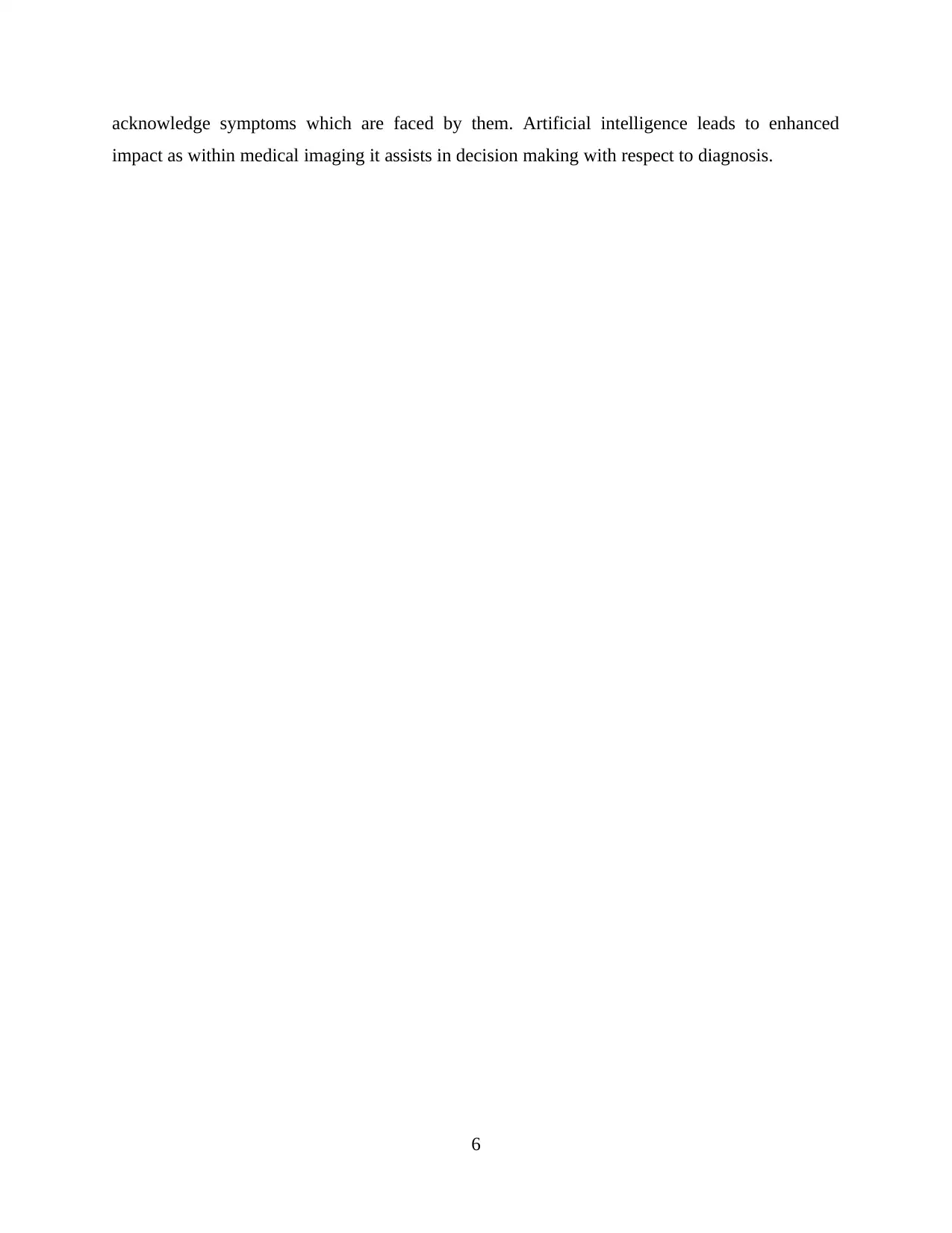
acknowledge symptoms which are faced by them. Artificial intelligence leads to enhanced
impact as within medical imaging it assists in decision making with respect to diagnosis.
6
impact as within medical imaging it assists in decision making with respect to diagnosis.
6
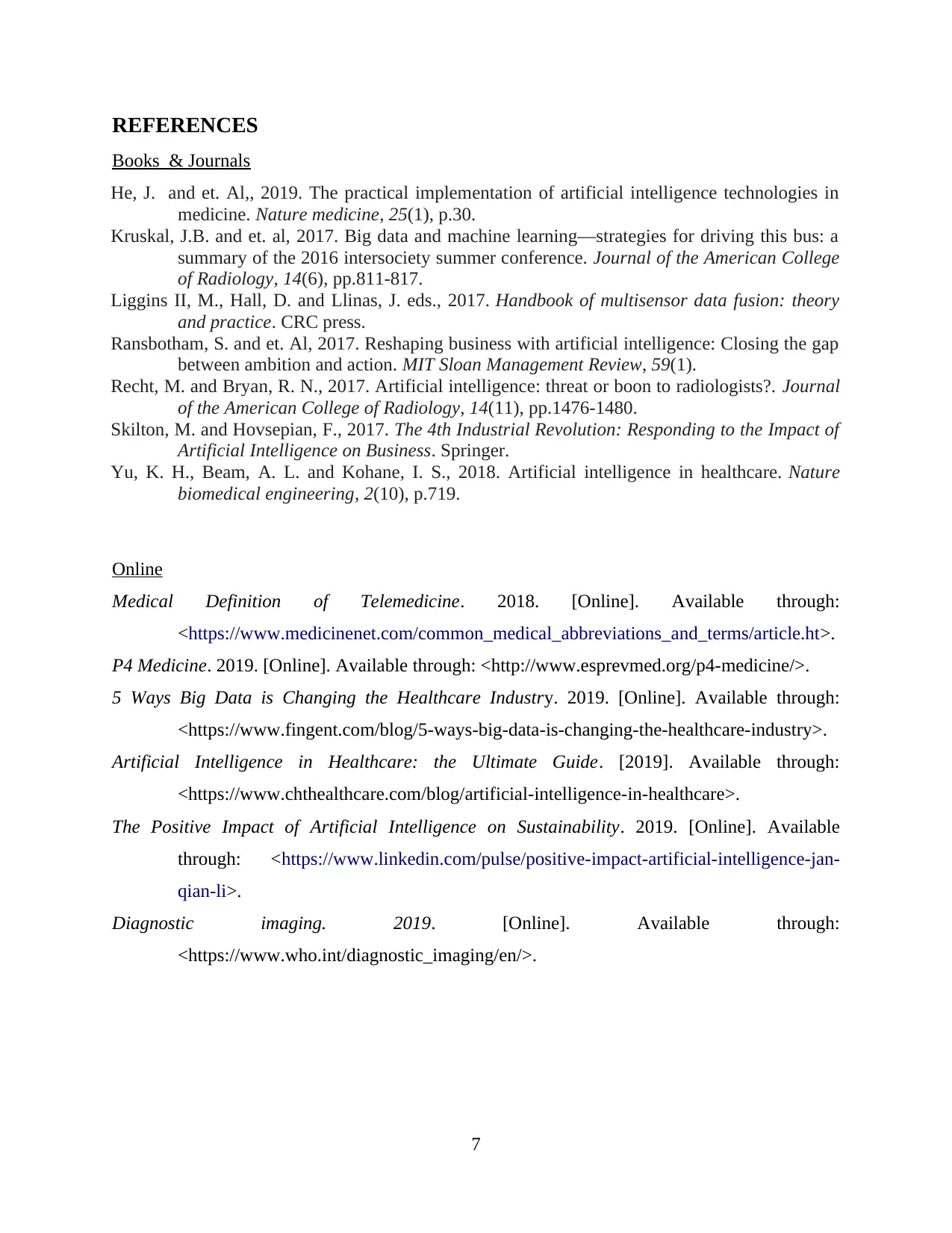
REFERENCES
Books & Journals
He, J. and et. Al,, 2019. The practical implementation of artificial intelligence technologies in
medicine. Nature medicine, 25(1), p.30.
Kruskal, J.B. and et. al, 2017. Big data and machine learning—strategies for driving this bus: a
summary of the 2016 intersociety summer conference. Journal of the American College
of Radiology, 14(6), pp.811-817.
Liggins II, M., Hall, D. and Llinas, J. eds., 2017. Handbook of multisensor data fusion: theory
and practice. CRC press.
Ransbotham, S. and et. Al, 2017. Reshaping business with artificial intelligence: Closing the gap
between ambition and action. MIT Sloan Management Review, 59(1).
Recht, M. and Bryan, R. N., 2017. Artificial intelligence: threat or boon to radiologists?. Journal
of the American College of Radiology, 14(11), pp.1476-1480.
Skilton, M. and Hovsepian, F., 2017. The 4th Industrial Revolution: Responding to the Impact of
Artificial Intelligence on Business. Springer.
Yu, K. H., Beam, A. L. and Kohane, I. S., 2018. Artificial intelligence in healthcare. Nature
biomedical engineering, 2(10), p.719.
Online
Medical Definition of Telemedicine. 2018. [Online]. Available through:
<https://www.medicinenet.com/common_medical_abbreviations_and_terms/article.ht>.
P4 Medicine. 2019. [Online]. Available through: <http://www.esprevmed.org/p4-medicine/>.
5 Ways Big Data is Changing the Healthcare Industry. 2019. [Online]. Available through:
<https://www.fingent.com/blog/5-ways-big-data-is-changing-the-healthcare-industry>.
Artificial Intelligence in Healthcare: the Ultimate Guide. [2019]. Available through:
<https://www.chthealthcare.com/blog/artificial-intelligence-in-healthcare>.
The Positive Impact of Artificial Intelligence on Sustainability. 2019. [Online]. Available
through: <https://www.linkedin.com/pulse/positive-impact-artificial-intelligence-jan-
qian-li>.
Diagnostic imaging. 2019. [Online]. Available through:
<https://www.who.int/diagnostic_imaging/en/>.
7
Books & Journals
He, J. and et. Al,, 2019. The practical implementation of artificial intelligence technologies in
medicine. Nature medicine, 25(1), p.30.
Kruskal, J.B. and et. al, 2017. Big data and machine learning—strategies for driving this bus: a
summary of the 2016 intersociety summer conference. Journal of the American College
of Radiology, 14(6), pp.811-817.
Liggins II, M., Hall, D. and Llinas, J. eds., 2017. Handbook of multisensor data fusion: theory
and practice. CRC press.
Ransbotham, S. and et. Al, 2017. Reshaping business with artificial intelligence: Closing the gap
between ambition and action. MIT Sloan Management Review, 59(1).
Recht, M. and Bryan, R. N., 2017. Artificial intelligence: threat or boon to radiologists?. Journal
of the American College of Radiology, 14(11), pp.1476-1480.
Skilton, M. and Hovsepian, F., 2017. The 4th Industrial Revolution: Responding to the Impact of
Artificial Intelligence on Business. Springer.
Yu, K. H., Beam, A. L. and Kohane, I. S., 2018. Artificial intelligence in healthcare. Nature
biomedical engineering, 2(10), p.719.
Online
Medical Definition of Telemedicine. 2018. [Online]. Available through:
<https://www.medicinenet.com/common_medical_abbreviations_and_terms/article.ht>.
P4 Medicine. 2019. [Online]. Available through: <http://www.esprevmed.org/p4-medicine/>.
5 Ways Big Data is Changing the Healthcare Industry. 2019. [Online]. Available through:
<https://www.fingent.com/blog/5-ways-big-data-is-changing-the-healthcare-industry>.
Artificial Intelligence in Healthcare: the Ultimate Guide. [2019]. Available through:
<https://www.chthealthcare.com/blog/artificial-intelligence-in-healthcare>.
The Positive Impact of Artificial Intelligence on Sustainability. 2019. [Online]. Available
through: <https://www.linkedin.com/pulse/positive-impact-artificial-intelligence-jan-
qian-li>.
Diagnostic imaging. 2019. [Online]. Available through:
<https://www.who.int/diagnostic_imaging/en/>.
7
⊘ This is a preview!⊘
Do you want full access?
Subscribe today to unlock all pages.

Trusted by 1+ million students worldwide
1 out of 9
Related Documents
Your All-in-One AI-Powered Toolkit for Academic Success.
+13062052269
info@desklib.com
Available 24*7 on WhatsApp / Email
![[object Object]](/_next/static/media/star-bottom.7253800d.svg)
Unlock your academic potential
Copyright © 2020–2025 A2Z Services. All Rights Reserved. Developed and managed by ZUCOL.





